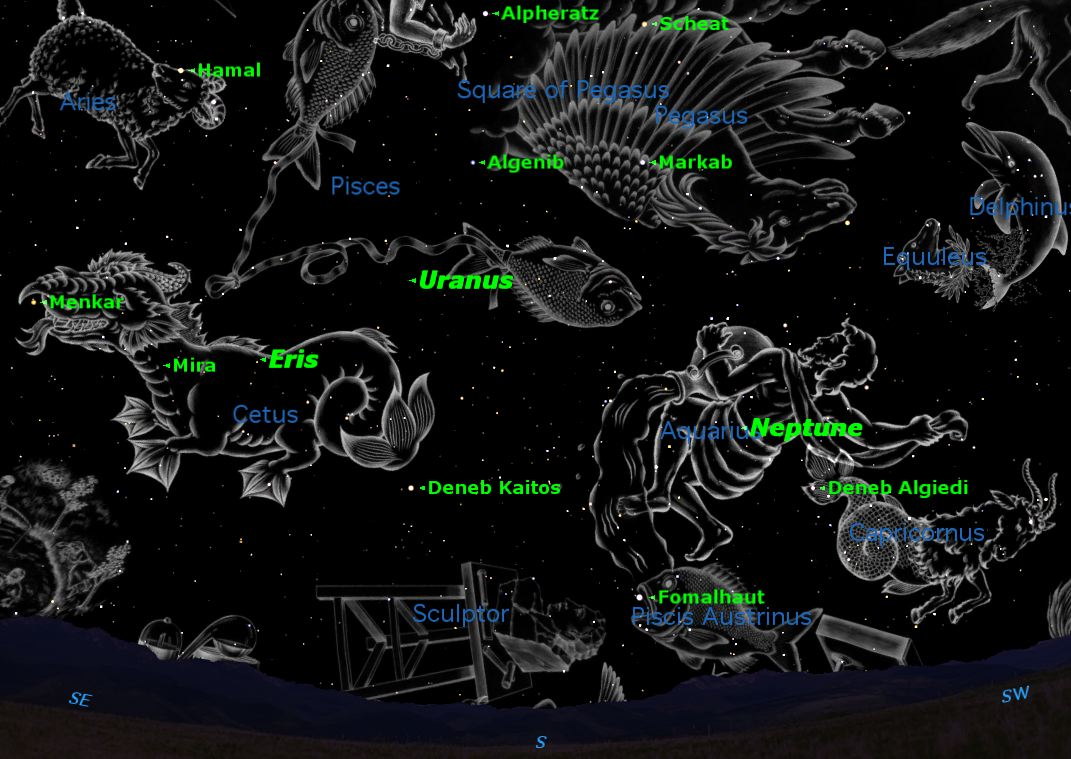Monsters of the Night Sky: Strange Constellations to See This Fall

As the constellations of summer depart from our sky, they are replaced by what are often called "the watery constellations." These include normal sea creatures like fishes and dolphins, and even Aquarius carrying a water jug.
Among these watery creatures are some strange creatures which we would call monsters: strange combinations of parts of unrelated animals.
The first to appear is Capricornus, the Sea Goat. Seen in the lower right of our chart looking southward on an autumn evening in the Northern Hemisphere, he combines the front end of a goat with the rear end of a fish. Most people would be hard pressed to see either a goat or a fish in this large triangular group of stars. I see it more as a tricorn hat turned upside down. The front end of the goat, to the right, is marked by two wide double stars, Algedi and Dabih, a fine sight in binoculars."Algedi" or "Al Giedi" is Arabic for "the goat." The rear end of the fish is marked by Deneb Algiedi, which translates from Arabic as "the tail of the goat." [Star Quiz: Test Your Stellar Smarts]
Much of our knowledge of ancient astronomy, along with mathematics and other sciences, has been passed down to us by medieval Arab scholars. In the process many of the old star names were translated into Arabic.
As a result, astronomers learn a bit of Arabic. "Deneb" is Arabic for tail, so turns up in many star names in constellations derived from animals. The most famous is Deneb in Cygnus, marking the tail of the Swan.
"Al" is Arabic for "the" and turns up in many scientific words like "algebra," "alcohol," and "alkali."
In the lower left corner of our chart we find another monster, Cetus. Modern astronomy books usually translate this as "the whale," but our chart shows a much stranger creature. it has the head of a dragon, webbed feet, and a fishy tail. This tail is marked by one of the few bright stars in this part of the sky, Deneb Kaitos. With our new knowledge of Arabic, we can translate this easily as "the tail of the whale."
Get the Space.com Newsletter
Breaking space news, the latest updates on rocket launches, skywatching events and more!
Buried in the heart of Cetus is a remarkable star called Mira, which means “wonderful” in Latin. This was discovered by David Fabricius in 1596 to be a star which varies in brightness, one of the first variable stars to be discovered.
Flying high above these watery creatures is yet another monster, a horse with wings called the Pegasus constellation. This is probably one of the most familiar mythological creatures, so familiar that most people never think of how strange a flying horse would be. The celestial flying horse is marked by four fairly bright stars forming an almost perfect square, the Square of Pegasus.
When I first went looking for Pegasus in the sky, I made a common beginner's error. Because I was using a small star chart, I looked for a small square of stars in the sky, and totally missed it. The constellations in the sky are much larger than they appear on star charts. So look for a really large square of stars.
Actually, only three of the four stars in the Square are part of Pegasus. The star in the upper left corner is Alpheratz, actually part of the constellation of Andromeda. But that is another story.
This article was provided to SPACE.com by Starry Night Education, the leader in space science curriculum solutions. Follow Starry Night on Twitter @StarryNightEdu.
Join our Space Forums to keep talking space on the latest missions, night sky and more! And if you have a news tip, correction or comment, let us know at: community@space.com.

Geoff Gaherty was Space.com's Night Sky columnist and in partnership with Starry Night software and a dedicated amateur astronomer who sought to share the wonders of the night sky with the world. Based in Canada, Geoff studied mathematics and physics at McGill University and earned a Ph.D. in anthropology from the University of Toronto, all while pursuing a passion for the night sky and serving as an astronomy communicator. He credited a partial solar eclipse observed in 1946 (at age 5) and his 1957 sighting of the Comet Arend-Roland as a teenager for sparking his interest in amateur astronomy. In 2008, Geoff won the Chant Medal from the Royal Astronomical Society of Canada, an award given to a Canadian amateur astronomer in recognition of their lifetime achievements. Sadly, Geoff passed away July 7, 2016 due to complications from a kidney transplant, but his legacy continues at Starry Night.










